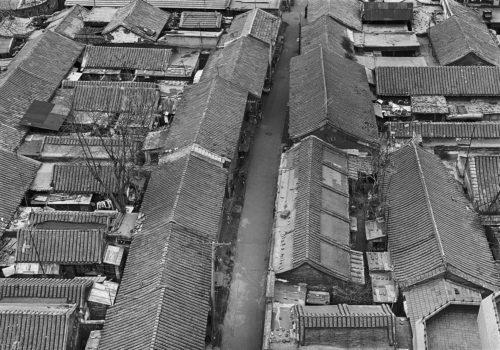A favorite from our collaborator Jean Loh.
Xu Yong is one of the very few Chinese photographers for whom I have the greatest admiration, for the simple reason that he seems to me to be the only one working on the passing of “time” and on preserving our collective “memory”. In a society that has made official a consistent policy of amnesia, through censorship of history teachings, especially of certain fundamental chapters of the country’s contemporary history, and by obliterating any publication of these episodes in books, newspapers, magazines and on social networks, we cannot neglect Xu Yong’s work.
This new edition of his “101 Hutongs” epitomizes the nostalgia of a long-lost Old Beijing and the erased memory of history and people. While technically the shooting modus operandi can be compared to Hiroshi Sugimoto’s “Theaters”, but one is sitting in the dark inside an enclosed space, the other is standing outdoor in broad daylight in the street. Xu Yong’s initial purpose of using long exposure with tiny aperture on his camera fixed on a tripod was to avoid letting in the picture the relentless passing of bicycles and the curious crowd of residents who came out to watch him working in these narrow lanes of Hutongs, the final result amounts to revealing all the details of the Hutong architecture but at the same time the damage of time passed or the scars of the cultural revolution. The absence of human figures led us to reflect on the chilling practice of denying the individual for the benefit of the collectivity.
While preserving history is the primary function of photography: to help us not to forget. Xu Yong’s first feat of arms relates precisely to his own “reportage” on what he modestly calls the “Tiananmen incident” of May-June 1989. Being a witness day after day to the incident that almost became the turning point in the history of contemporary China, he had the intelligence to have his photographs published – in Hong Kong, when it was still possible – in a book that he called “NEGATIVES”, with images reproducing exactly the negatives of his color films, but reversing the reading of the colors (the black hair of the protesters becomes white, the red color of flags and banners turns green). Chinese characters written in slogans have been reversed from right to left, so as to confuse an average Chinese reader. The meaning of “negative” in photography usually is the opposite of “positive” in photo printing language, it also means what is not allowed to see, what is defined as “bad” as contrary to “good”, as a result negative elements should be censored, in fact. After documenting residents evicted from their homes because of the crazy pace of real estate development, Xu Yong photographed them holding a sign bearing their names and dates of arrival in Beijing, and published a book “Backdrops” in 2007 with the American publisher Timezone 8 based in Beijing. Including real-fake souvenir photos of tourists posing in front of iconic Tiananmen Square in Beijing and the iconic Oriental Pearl Tower in Shanghai, hence the term “backdrop”. Three years later, Xu Yong published his boldest opus entitled “18% Gray” with totally blurred urban landscape in which it was totally impossible to identify monuments or famous streets… a true lamentation by Xu Yong on the reigning amnesia in China. In 2011 Xu Yong innovated again with an even more daring publication “This Face”, this face of Zi Yu’s, a sex worker, whom Xu Yong photographed in close-up shots throughout an entire day, from the getting up in the morning till back to bed at nightfall. One can see the transformation of the young woman’s face, from a pure face without a trace of makeup and to a face with full makeup, before and after a session with a client, with lipstick crushed across her cheek, looking excited to looking exhausted, a face lit by the daylight to a face illuminated by the bedside lamp’s yellow light, in each photo her eyes just staring straight into the lens. I remember my shock when I went to his spacious gallery in the 798 art district where he arranged to lay out 500 portraits on a long stretch of easel in a continuous sequence of “time”, hour after hour…. A unique unprecedented work, truly one of its kind, this compact 568-page book contains also the diary of the young woman he calls Zi U and with whom he had indeed offered to share the copyright, as he considered it as a collaborative work.
Born in Shanghai in 1954, the artist Xu Yong graduated from Henan University of Science and Technology in China in 1978 and worked as a photographer for the state-run Beijing Advertising Agency in the 1980s. He shot “101 Portraits of Hutong” in the late 1980s and published them in 1990, breaking through the then unofficial restriction regarding hutongs as a restricted area. He used a unique and specially composed photographic language to present those hutongs marked by hundreds of years of history and vicissitudes while still remaining as the true face of Beijing. Key publications of Xu Yong include “Solution Scheme”, “This Face”, “Negatives: Scans”, and “18% Grey”. In 1993, the artist initiated and organized the “Hutong Cultural Tour” to actively publicize and promote the protection of Beijing’s hutongs. In 2003, he became one of the funders the famous “798 Art District”.
Jean Loh
















